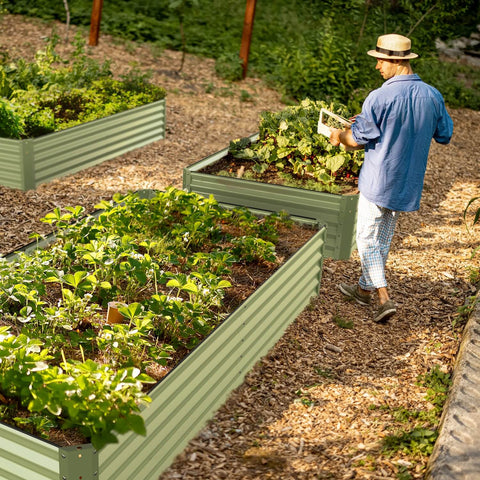Elevated garden beds are an increasingly popular planting option in horticulture, providing good drainage and ventilation to protect the growing environment. Filling materials are one of the key factors in building an elevated garden bed. This article covers some common filling materials and provides some considerations to help you create a beautiful elevated garden bed.The following content also has some reference value for raised garden beds.
First, the selection of filling materials
Drainage performance: The filling material should have good drainage performance to avoid excessive water retention in the bed, affecting the growth of plants.
Water retention properties: While drainage properties are important, the filling material should also have some water retention capacity to ensure adequate water for plants during dry periods.
Light material: The filling material for the elevated garden bed should be light material to reduce the burden of the bed and facilitate movement.
Stomatal properties: The filling material should have good stomatal properties to promote soil ventilation and root respiration.

Durability: The filling material should have certain durability and can maintain structural stability for a long time.
Two, common filling materials
Vermiculite granules: Vermiculite granules are porous ore materials with good drainage properties and water retention. It regulates the pH of the soil and provides essential nutrients for plants.
Grass sawdust: Grass sawdust is a common filler material that is derived from discarded plant material such as trees and lawn trims. Grass and wood chips increase soil aeration and water retention and improve soil fertility.
Mushroom residue: Mushroom residue is the leftover waste of mushroom cultivation process, which has good water retention performance and nutrient content. It can provide an elevated garden bed with rich organic matter that promotes healthy plant growth.
Hardwood chips: Hardwood chips are made from hardwood and have a long decomposition period and good durability. It increases the aeration and water retention of the soil, while also absorbing excess water and preventing root rot.
Asbestos cement board: Asbestos cement board is a lightweight, durable infilling material that provides a stable support structure for an elevated garden bed. However, safety concerns need to be taken into account when using asbestos cement boards, as asbestos poses a certain health risk to humans.
Three, when choosing the filling material, the following are some more detailed tips and precautions:
Know the properties of the materials: It is very important to know the properties of each material before choosing a filling material. Learn about their drainage, water retention, aeration, durability, and effect on plant growth. This will help you better judge which material is best for your elevated garden bed.
Study adaptability: Different plants have different adaptability requirements for filling materials. Some plants may need better drainage, while others may need more water retention. When choosing fill materials, consider the species of plants you plan to plant and choose the material that best suits their needs.
Consider mixing: Depending on your needs, you can consider mixing different fill materials. This can make full use of the advantages of various materials and achieve a better balance in terms of drainage performance, water retention capacity and ventilation. Mixing also helps to provide better soil structure and nutrient balance.

Availability and cost of materials: When selecting fill materials, consider their availability and cost. Some materials may be more accessible and affordable in your area. Choosing materials that are available and affordable can help you save money and make it easier to build an elevated garden bed.
Refer to the experience and advice of others: When choosing filling materials, refer to the experience and advice of other gardening enthusiasts or professionals. They may have valuable insights into the practical use effects, advantages and disadvantages of a particular material. Through their experience, you can better understand the suitability and feasibility of the material.
Experiment and adjust: Filling material selection is not a one-time decision. If you haven't determined the best filling material for your elevated garden bed, experiment and adjust it on a small scale. Try different combinations of materials on a small scale and observe their effects on plant growth. Based on the observations, gradually adjust the proportion and type of filling material to find the best combination.
Choosing the right filling material is key to creating a beautiful elevated garden bed. According to their own needs and environmental conditions, comprehensive consideration of drainage performance, water retention capacity, lightweight, porosity and durability and other factors, choose the appropriate filling material. At the same time, maintain the bed regularly to ensure the healthy growth of the plant. Through scientific selection and proper use, you will be able to create a pleasant and beautiful elevated garden bed for the pleasure of gardening









